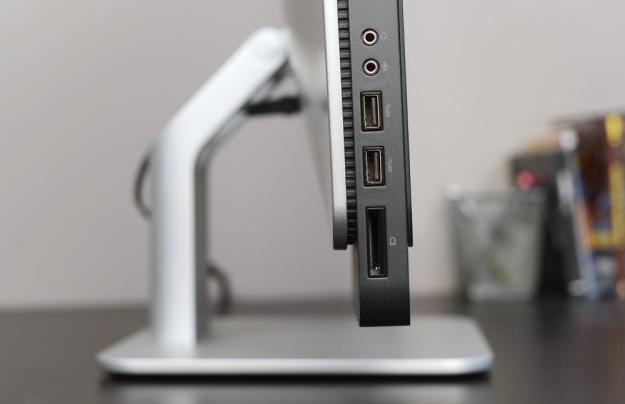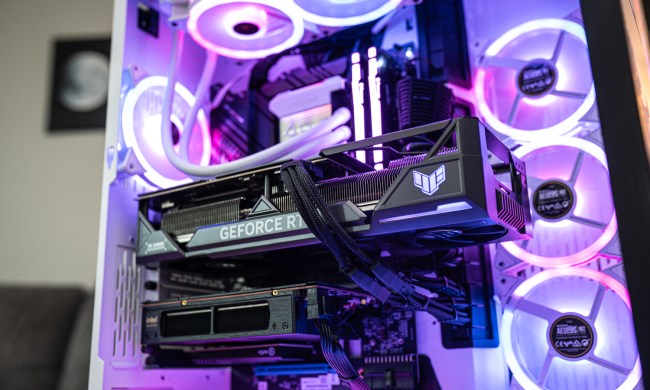“All-in-one computers require some tradeoffs, but if you’re willing to sacrifice future upgrades for a more attractive and better-integrated PC, the XPS One 27 is the computer to buy.”
- Good design
- Beautiful 2560 x 1440 display
- Excellent sound quality
- Useful connectivity
- Respectable performance
- Stand does not swivel or adjust for height
- Extremely glossy display finish
- Graphics processing unit can’t handle modern games at native resolution
The all-in-one computer market has been injected with steroids. Back in 2009, the iMac popularized going big with its 27-inch model, and competitors have followed Cupertino’s lead. Earlier this year, we reviewed the massive HP Omni 27. Now we’ve received an equally massive Dell XPS One 27-inch.
Like most Dell XPS products, this all-in-one isn’t meant to be a budget solution. Its least expensive configuration comes with a price tag of $1,399. For that you receive a Core i5 processor, Intel-integrated graphics and 6GB of RAM. Our review unit came equipped with a Core i7 processor, 8GB of RAM and an Nvidia GT 640M graphics solution, which would run $1,799.
That’s a lot of money, but this isn’t your typical PC. Like the HP Omni 27, the XPS One tries to justify its price with striking design and a wonderful display. The Omni faltered in reaching this goal. Can Dell do better?
Better from the back
The rear panel on the XPS One is a nice, curved surface that looks intriguing and feels solid. A big, heavy stand made of silver matte metal keeps the computer upright. There’s no denying the XPS One is reminiscent of the Apple iMac, which is fine – the iMac is a heck of a good-looking computer.

From the front, the aesthetics are a little more boring. It’s is simply a glossy display surrounded by a thick glossy black bezel. Below this lies a strip of dark gray plastic material that is intended to be an accent, but simply blends in with the rest of the computer.
We had hoped that Dell carried over the excellent four-way adjustable stands found on many of the company’s Ultrasharp monitors. That’s not the case. No competitor does stands better, so this seems like a missed opportunity for Dell.
Build quality is OK, but the attractive rear panel is plastic, not metal, and many areas are poorly reinforced. Gripping the monitor from the top to adjust it downward, for example, can easily cause the plastic there to flex and bend. This causes no damage, but it makes this expensive computer feel cheap.
Connectivity
The Dell XPS One offers decent connectivity. Four USB 3.0 ports run along the back, and two more USB 3.0 ports are available at the front. Six ports aren’t many, but it’s great that they’re all 3.0. The front left flank also includes individual headphone and microphone jacks, as well as an SD card.

The real focus, however, is video connectivity. Dell shipped our XPS One with a television tuner. The computer also came with HDMI-In, HDMI-Out and S/PDIF out. You can use the XPS One as part of a home entertainment system (although it’s too small for a primary display) or as the primary entertainment device in a bedroom or office.
Not every XPS One includes a television tuner, but only the most basic model lacks it. Other connectivity remains the same across different models.
The display steals the show
One issue with the HP Omni 27 was its display, which offered “only” 1080 pixels. Dell has the potential to rectify this; after all, it makes some of the best consumer and professional displays on the market.
Dell ran with this advantage. The 27-inch display on the XPS One offers resolution of 2560 x 1440. Unlike the HP Omni 27, which suffered from screen-door effect and chunky rendering of small text, the XPS One is butter-smooth. Everything is crisp.
Quality is good, too. We witnessed good black-level performance, extremely smooth gradient banding performance and excellent color accuracy. Some better displays are on the market, but overall, this panel outperforms the majority of the competition. And that includes stand-alone monitors.

Users may have some trouble with glare, however. The glass covering this display is reflective (of course), and the backlight isn’t up to countering the glare you get when you use the computer in a bright room. Our test office can become bright in the early afternoon, and this all-in-one proved a pain to use with the blinds open.
The XPS One has room for audio equipment, and it’s put to use, resulting in excellent clarity with a decent helping of bass. Distortion became a problem at high volume, but the XPS One is plenty loud even at half of its potential. Most users will have no need for an external sound system unless they call upon the XPS One to act as a home theater PC.
Decent peripherals
Users may find the 27-inch panel on this computer enchanting, but they’ll have no reason to touch it. A touchscreen is not even available as an option. We didn’t mind this for a second. A touchscreen is worth little on a Windows 7 PC unless it also ships with interface customizations.

Dell ships the computer with a keyboard and mouse. The mouse is a base two-button model with a scroll wheel but should be adequate for most users. The basic but usable keyboard offers reasonable typing feel and a spacious layout. You can buy a much better unit, but not for less than $30. Most people will find the included keyboard to be all they ever need.
Uh, where’s the bloatware?
Many geeks readily associate Dell with bloatware, but the company is aware that pre-installed apps don’t often lend themselves to a premium experience. This expensive all-in-one ships with nothing on the desktop except the recycle bin and with no extra icons in the taskbar.
We were even more pleased to find that Dell uses its traditional display-menu system to control functions such as volume and display brightness. You can access some features via the keyboard while you can control others by using touch-sensitive buttons on the computer’s front panel.
Conservative performance
Dell’s new all-in-one may be huge, but that doesn’t mean it has room for a normal-voltage Intel Core processor. The low-voltage “S” versions are the only choice. Ours arrived with the Intel Core i7-3770s, the most powerful processor Dell offers in this model.
We found the processor’s performance to be good but not as quick as a normal Core i7 quad. The SiSoft Sandra Processor Arithmetic benchmark returned a combined score of 103.29, while the 7-Zip bench offered a combined score of 29,034. These figures are toe-to-toe with mobile Core i7 quad-core processors. For example, the Alienware M17x provides a score of 100.27 in SiSoft Sandra.
PCMark 7 spoke well of the system’s overall performance by reporting a score of 4,485. This, once again, is on par with the best laptops but short of a traditional desktop PC. Strong processor performance and system storage scores (the XPS One offers a solid-state cache drive) were the main contributors to the final tally.
The laptop performance theme returns with the Nvidia GT 640M graphics solution. This mobile part is based on the green team’s latest architecture, but it is also a low-end, entry-level solution. 3DMark 06 reached a score of 12,860, and 3DMark 11 was able to crank out 1,980.
These would be decent scores for a laptop, but they just don’t cut it in a system with a price tag this high and a display this beautiful. Most modern 3D games are only playable at 1600 x 900 or 1920 x 1080 at low-to-medium detail, and games played at those resolutions look poor when stretched to 2560 x 1440. Anyone who wants to do serious gaming will need to look elsewhere.
The warm, quiet type
Noise levels were not an issue with this all-in-one. Whatever noise the system made at idle dissolved readily into the room’s ambient noise. A box fan in another room can completely obscure the sound the XPS One produces. Volume at load was higher, but still tolerable.
Even so, this all-in-one (like all computers) can put out a surprising amount of heat. The rear panel always feels warm to the touch no matter the load we placed on the computer. This is the reason even a large all-in-one has to use a low-voltage processor and a laptop graphics processing unit. Stuffing in desktop hardware would make the heat unmanageable without aggressive (and loud) fans.
Conclusion
All-in-one computers require some tradeoffs, but if you’re willing to sacrifice future upgrades for a more attractive and better-integrated PC, the XPS One 27 is the computer to buy. It offers an amazing display, good performance and a reasonable value.
It also lacks any glaring faults, which means we find no reason why we cannot recommend this system to someone interested in an all-in-one. The high price is the only obstacle, but you get what you pay for.
Highs
- Good design
- Beautiful 2560 x 1440 display
- Excellent sound quality
- Useful connectivity
- Respectable performance
Lows
- Stand does not swivel or adjust for height
- Extremely glossy display finish
- Graphics processing unit can’t handle modern games at native resolution




